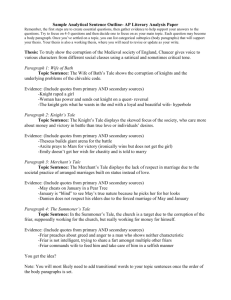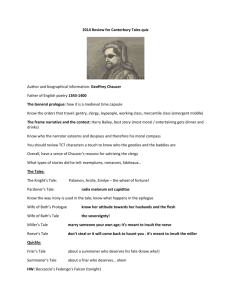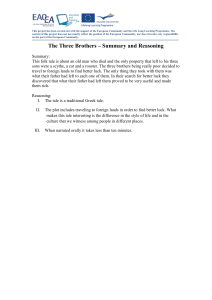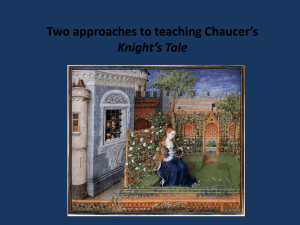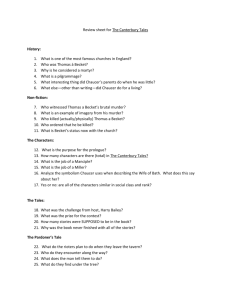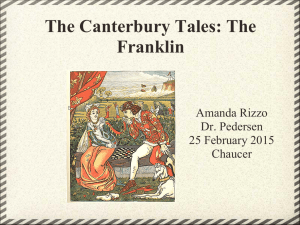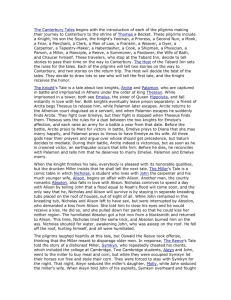THE CANTERBURY TALES
advertisement
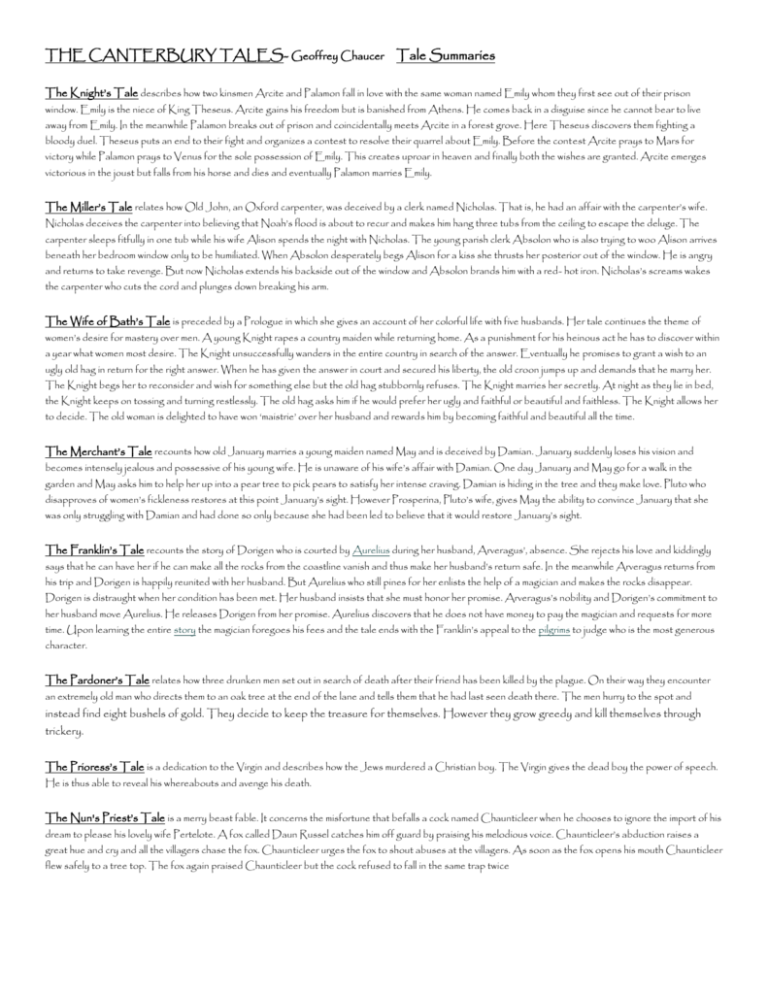
THE CANTERBURY TALES- Geoffrey Chaucer Tale Summaries The Knight’s Tale describes how two kinsmen Arcite and Palamon fall in love with the same woman named Emily whom they first see out of their prison window. Emily is the niece of King Theseus. Arcite gains his freedom but is banished from Athens. He comes back in a disguise since he cannot bear to live away from Emily. In the meanwhile Palamon breaks out of prison and coincidentally meets Arcite in a forest grove. Here Theseus discovers them fighting a bloody duel. Theseus puts an end to their fight and organizes a contest to resolve their quarrel about Emily. Before the contest Arcite prays to Mars for victory while Palamon prays to Venus for the sole possession of Emily. This creates uproar in heaven and finally both the wishes are granted. Arcite emerges victorious in the joust but falls from his horse and dies and eventually Palamon marries Emily. The Miller’s Tale relates how Old John, an Oxford carpenter, was deceived by a clerk named Nicholas. That is, he had an affair with the carpenter’s wife. Nicholas deceives the carpenter into believing that Noah’s flood is about to recur and makes him hang three tubs from the ceiling to escape the deluge. The carpenter sleeps fitfully in one tub while his wife Alison spends the night with Nicholas. The young parish clerk Absolon who is also trying to woo Alison arrives beneath her bedroom window only to be humiliated. When Absolon desperately begs Alison for a kiss she thrusts her posterior out of the window. He is angry and returns to take revenge. But now Nicholas extends his backside out of the window and Absolon brands him with a red- hot iron. Nicholas’s screams wakes the carpenter who cuts the cord and plunges down breaking his arm. The Wife of Bath’s Tale is preceded by a Prologue in which she gives an account of her colorful life with five husbands. Her tale continues the theme of women’s desire for mastery over men. A young Knight rapes a country maiden while returning home. As a punishment for his heinous act he has to discover within a year what women most desire. The Knight unsuccessfully wanders in the entire country in search of the answer. Eventually he promises to grant a wish to an ugly old hag in return for the right answer. When he has given the answer in court and secured his liberty, the old croon jumps up and demands that he marry her. The Knight begs her to reconsider and wish for something else but the old hag stubbornly refuses. The Knight marries her secretly. At night as they lie in bed, the Knight keeps on tossing and turning restlessly. The old hag asks him if he would prefer her ugly and faithful or beautiful and faithless. The Knight allows her to decide. The old woman is delighted to have won ‘maistrie’ over her husband and rewards him by becoming faithful and beautiful all the time. The Merchant’s Tale recounts how old January marries a young maiden named May and is deceived by Damian. January suddenly loses his vision and becomes intensely jealous and possessive of his young wife. He is unaware of his wife’s affair with Damian. One day January and May go for a walk in the garden and May asks him to help her up into a pear tree to pick pears to satisfy her intense craving. Damian is hiding in the tree and they make love. Pluto who disapproves of women’s fickleness restores at this point January’s sight. However Prosperina, Pluto’s wife, gives May the ability to convince January that she was only struggling with Damian and had done so only because she had been led to believe that it would restore January’s sight. The Franklin’s Tale recounts the story of Dorigen who is courted by Aurelius during her husband, Arveragus’, absence. She rejects his love and kiddingly says that he can have her if he can make all the rocks from the coastline vanish and thus make her husband’s return safe. In the meanwhile Arveragus returns from his trip and Dorigen is happily reunited with her husband. But Aurelius who still pines for her enlists the help of a magician and makes the rocks disappear. Dorigen is distraught when her condition has been met. Her husband insists that she must honor her promise. Arveragus’s nobility and Dorigen’s commitment to her husband move Aurelius. He releases Dorigen from her promise. Aurelius discovers that he does not have money to pay the magician and requests for more time. Upon learning the entire story the magician foregoes his fees and the tale ends with the Franklin’s appeal to the pilgrims to judge who is the most generous character. The Pardoner’s Tale relates how three drunken men set out in search of death after their friend has been killed by the plague. On their way they encounter an extremely old man who directs them to an oak tree at the end of the lane and tells them that he had last seen death there. The men hurry to the spot and instead find eight bushels of gold. They decide to keep the treasure for themselves. However they grow greedy and kill themselves through trickery. The Prioress’s Tale is a dedication to the Virgin and describes how the Jews murdered a Christian boy. The Virgin gives the dead boy the power of speech. He is thus able to reveal his whereabouts and avenge his death. The Nun's Priest’s Tale is a merry beast fable. It concerns the misfortune that befalls a cock named Chaunticleer when he chooses to ignore the import of his dream to please his lovely wife Pertelote. A fox called Daun Russel catches him off guard by praising his melodious voice. Chaunticleer’s abduction raises a great hue and cry and all the villagers chase the fox. Chaunticleer urges the fox to shout abuses at the villagers. As soon as the fox opens his mouth Chaunticleer flew safely to a tree top. The fox again praised Chaunticleer but the cock refused to fall in the same trap twice
